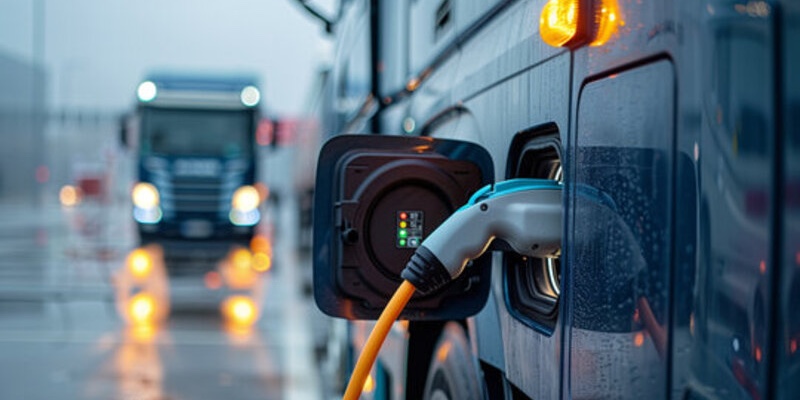The Megawatt Charging System’s (MCS) ability to deliver up to 1 MW of power is generating excitement in the heavy-duty sector, as it could significantly reduce eTruck charging times.
However, as charger manufacturers move forward with their implementation, vehicle developers emphasize the importance of considering the actual capacity of electric trucks.
“We need to focus on what the trucks can handle,” Carlos Espada, Zero Emissions Business Development Manager at DAF Trucks, tells Mobility Portal España.
The reason?
From their perspective, rather than prioritizing charging infrastructure in megawatts, development should focus on the vehicles’ endurance to receive high power outputs without affecting their life cycle or increasing operating costs.
Within this framework, it proposes achieving a balance that ensures everything is profitable, also considering the optimization of battery life as a factor in economic sustainability.
“If batteries are charged too heavily, they experience greater wear and tear, which inevitably reduces their lifespan and, consequently, increases the total cost of ownership (TCO),” Espada explains.
And he emphasizes: “It’s not viable to implement a technology today, considering the investment it entails, if its usefulness and the existence of an adequate infrastructure to support it aren’t guaranteed.”

In other words, charging speed cannot compromise the durability of the electric truck’s most expensive component.
Therefore, one of the greatest challenges is to guarantee competitive autonomy with the least possible degradation.
DAF Trucks, for example, has developed models that can travel up to 500 kilometers per charge, but its charging systems only support a maximum of 325 kW.
“Currently, we are one of the most independent companies on the market,” he emphasizes.
This performance is possible thanks to the use of lithium iron phosphate (LFP) batteries, a technology that the company considers the most suitable for heavy-duty transport.
The use of this material offers advantages in durability and safety.
“It’s a technology that’s more sustainable, and it also lasts longer, meaning it can withstand more charging cycles,” he notes.
Currently, most of the batteries used by the company come from Asia, but the firm is already investing in producing its own cells.
The PACCAR Group, parent company of DAF Trucks, has already begun construction of a battery plant in the United States.
This agreement will reduce dependence on the Asian market and ensure a more stable and competitive supply.
“The goal is to develop a more self-sufficient supply chain that is less vulnerable to global crises , as happened with microchips in 2021,” he explains.
The cost of the transition and the profitability of the eTruck
Beyond the technical dilemma, the adoption of electric heavy transport is subject to one factor: “Customers want to take the plunge, but it’s a matter of profitability.”
While electric trucks have a higher initial cost, the TCO can become more favorable over time.
In this context, Espada points out: “It is important to recognize that costs should not fall exclusively on a single actor, whether the manufacturer, the carrier, or the freight provider.”
On the contrary, he maintains that this should be a collaborative project, especially in the initial stages, until a balance is found.
This can manifest itself in a variety of ways.
“For example, large companies could install chargers at their facilities and offer free charging to the carrier when they arrive with their vehicle,” says the DAF Trucks representative.
And he explains that, as large companies, they tend to have more favorable agreements with electricity providers.
Meanwhile, carriers can assume their responsibility by taking the step toward this transition and meeting their customers’ needs.
While manufacturers work to optimize resources and bring competitive products to market.
“Ultimately, this is a matter of supply and demand: if the product is profitable and viable, it will sell, and the market for this type of vehicle will expand,” he explains.
Despite this, he does not rule out that the manufacturing costs of these products are high today.
“Introducing a vehicle like an electric truck to the market, with the costs it entails, means that someone must also bear those costs,” Espada says.
And he explains: “We all seek to ensure our share of the profitability, so we can’t introduce a product to the market that, from the outset, isn’t profitable for us.”
Therefore, he believes that, in this first phase, it is necessary for governments to take the initiative and promote the development of this sector.
The cost difference with diesel trucks remains an obstacle.
However, the supply and demand market itself could balance this situation in less than a decade.
“If I follow the European Union guidelines, by 2030 we should be equal to the costs of electric vehicles compared to diesel,” Espada says.
In this context, he emphasizes that electromobility should not only be analyzed in terms of direct costs, but also considering operational benefits.
Especially in a context where combustion-powered vehicles will face increased tax penalties, traffic restrictions, and stricter environmental regulations.








